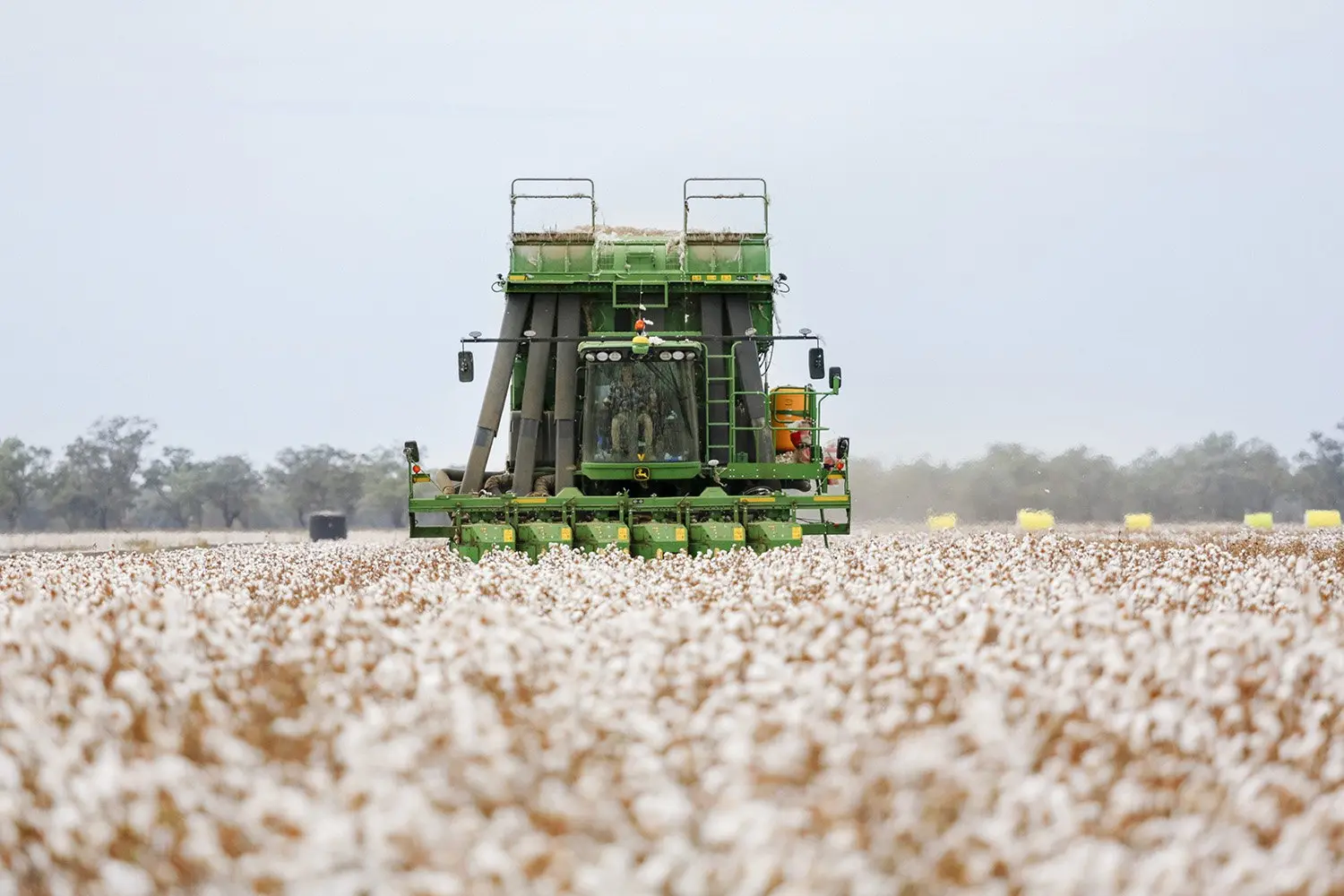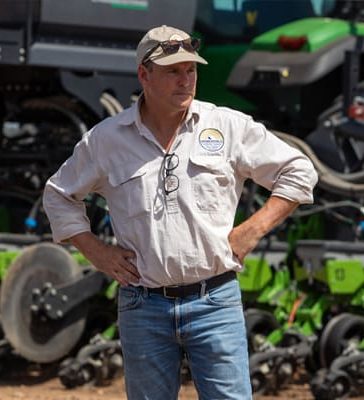
Cotton picking at Sundown Pastoral Company’s Keytah in Moree.
TRACEABLE cotton grown in a regenerative system could put more power and income in the hands of Australian growers, says Sundown Pastoral Company co-owner David Statham.
Mr Statham and his wife Danielle manage the operation which includes two large-scale cropping and grazing properties and a cotton gin, in partnership with Namoi Cotton.
The couple also founded supply chain traceability technology company FibreTrace, and the Better Earth Cotton regenerative farming program.
Mr Statham told the Digital Agrifood Summit held last week that Australian growers could be the key beneficiaries of changing expectations of clothing brands to provide environmentally friendly clothing to consumers.
He said it took Sundown five years to create the right strategy to receive a premium for growing regenerative cotton.
“The combination of having a carbon-positive story, as well as the ability to trace, is when we started to get people to pay,” Mr Statham said.
He said going directly to brands provided the best opportunity for change.
“It is the brands that have the problem, and it is the brands that have the responsibility.
“We are getting premiums…and it is without selling the carbon.”
EU driving change
Mr Statham said the European Union was a key force in making brands prove where and how its products were made.
In the EU by 2025, every item of clothing will be required to have traceability information as well as a CO2 score, or the brand will need to pay a garment tax.
“This is the opportunity for cotton farmers.”

David Statham. Photo: Bayer
Taking back control
Mr Statham said he had seen a rise in brands dealing directly with farmers due to the need to accurately trace cotton from paddock to garment.
“If you can tell that story, 50-60pc of the lifecycle of [a] shirt starts with…the farmer, and that is why they are going to come to us.
“These brands are now not going through merchants.
“It’s the second longest traded commodity in the world…and it is being driven by conglomerates, traders.
“Traders have a big problem coming because farmers have got the answer to the Europeans’ problem.”
Mr Statham said these changing dynamics put the power in the hands of growers.
“I am going to find the people who value what we do and get them to pay a premium.
“I am going to tell them what they are going to pay; they aren’t going to tell me.”
Traceability key
Mr Statham said proving their product’s regenerative credentials via supply chain tracing technology was essential to getting brands on board with paying a premium.
He said recent incidents of “greenwashing”, with companies inaccurately labeling garments as organic cotton, made consumers wary of these types of environmental claims.
He said the industry found “ten times more cotton was sold as organic than what was grown”.
“There is a massive opportunity to come to the table…with all these brands around the world who sunk all this money into organic cotton, and it’s all been found out for what it is.”
The Stathams’ FibreTrace company provided the proof brands needed to promote their sustainability claims.
It is a cloud-based platform which traces and verifies fibres for every stage of the textile supply chain.
“At the end of the day, you get a map of who has touched it, when they touched it, and the carbon footprint of the people who have touched it.”
Mr Statham said the company was also working with brands to have markers in fabrics to further add to the fabrics traceability credentials.
He said this “luminescent pigment” bonds to raw fibres, which “picks up a signal” and can detect if the original cotton fibre was blended with man-made or other fibres.
On-farm solutions
Sundown Pastoral Company’s two properties, cropping operation Keytah near Moree, and mixed enterprise St Ronan’s in north-eastern Queensland as well as the ginning facilities feature several regenerative practices to be certified as environmentally and climate positive.
Mr Statham said reduced tilling practices were the starting point followed by creating solutions to reduce carbon emissions from the ginning stage.
“About 85pc of my emissions [are] from two products – fuel and fertiliser.
“I am going to create it myself and it’ll be all green.”
He said there was currently a solar farm located adjacent to the Wathagar Gin which generates about 66pc of the energy needed to power the plant.
Mr Statham said the company, along with Hiringa Energy, will be constructing a green hydrogen and ammonia facility, which will cut the operation’s carbon emissions to almost nothing.
In another development, he said Sundown Pastoral was also working to convert the waste from the ginning process in biochar, which could be used as on crops as a green fertiliser.
The Digital Agrifood Summitt was held at Charles Sturt University, Wagga Wagga on October 11 and 12.



HAVE YOUR SAY